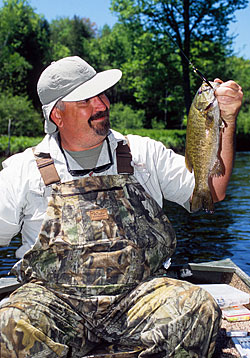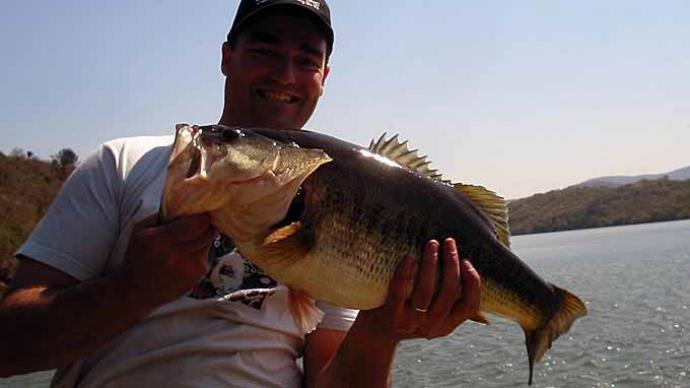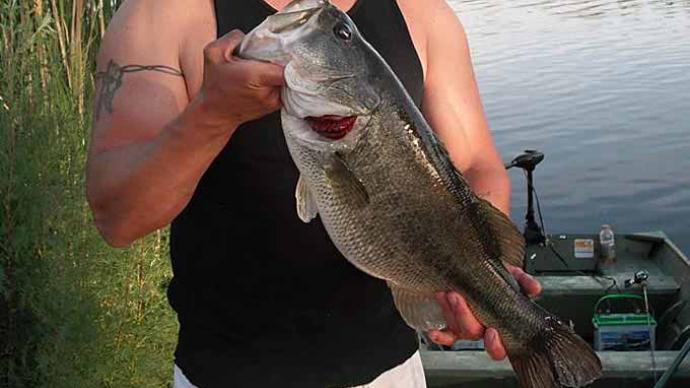
River fishing is tough for some species in August. Take trout, for example. Flows are low and clear, major hatches have ended; the water has warmed, so cold-water loving trout are lethargic. In August, catching river trout can be difficult, but not so with smallmouth bass.
Summer is the perfect time to chase river smallmouth bass. With lower flows, bass are concentrated in rivers and streams during the summer. That makes finding them much easier. Where warm water might make a trout languid, tepid water supercharges smallies. Their metabolism is in high gear; they’re feeding with reckless abandon, and the weather is delightful. What more could a river angler want?

Without a doubt, the number one item on a river smallmouth's menu is crawfish. Crawfish thrive in the same rivers and streams where smallmouth do well. Rivers that have rocks, boulders, gravel, ledges, the occasional log, stump, or downed tree, and some current provide ideal habitat for bass and crawdads. But crawdads are not the only thing river smallies feast on. There are plenty of aquatic insects in these clear, free-flowing streams and smallmouth gorge on both the larval stages and the adults when they're available. You'll find mayflies, stoneflies, caddisflies, and big, juicy, ugly hellgrammites, the larva of a dobsonfly, to be very common in most any smallmouth river.
Streams and rivers are home to an array of minnow species, too. There is a wide assortment of minnows, dace, darters, shiners, chubs, and sculpins that smallies feast on. Most minnow species are darker in color, which you should consider when selecting lures or flies. With so many food sources to choose from, a myriad of lures and flies will tempt river bass. That's one reason impressionistic lures and flies, like tubes, twister tails, Wooly Buggers, and Muddlers, do yeoman's work on brown bass in moving water. They have the potential to imitate a lot of things that smallmouths eat. If given a chance, smallmouths will even eat things like frogs, mice, and moths.
One of the attractions of summer smallmouth is the simplicity. You don't need a bunch of fancy gear to be successful. You can wade or float in a canoe or kayak, fish from the watercraft, or get out at prime locations. The water is usually warm enough in the summer you don't even need waders, but a pair of old sneakers is a good idea. A medium-light spinning outfit is perfect for those wanting to fish with spinning tackle. Reels spooled with 4- to 8-pound test line are fine, but you might want to add a barrel swivel and a short length of heavier fluorocarbon for a leader. Rocks and the sandpaper-like mouths of bass can quickly chafe lighter line.

You don't need a huge selection of lures for river smallmouth. There are a half dozen that will meet 99% of your needs. Tube jigs do a great job imitating a good cross-section of things that bass eat. Tubes can imitate minnows, crayfish, and other prey. A 3- to 4-inch tube in a darker color is about right to mimic smallmouth forage. Opt for a jig head inserted into the tube to allow the bait to slide over the bottom and obstructions without getting snagged. Select a jig head between 1/16- and 1/4 ounce that allows the lure to slip and slide along the bottom without becoming lodged. Tubes are great because you can swim them, hop them, and bounce them with good results in everything from pocket water, behind boulders, along seams, in riffles or dredge deeper pools.
Twister tails can be fished in much the same way as tubes if the chances for snags are less. Twisters are fish on a classic jig head, which increases the chances of getting wedged between rocks or boulders, but the slithering tail produces arm-jarring strikes. Twisters, like tubes, can imitate a variety of things that smallmouths eat or nothing at all. It doesn't seem to matter to the bass. Colors run the gambit from dark brown, motor oil, black and purple to white or silver to imitate minnows. Twister tails can be especially hot when added to a safety pin-type spinner.
Friend and smallmouth bass expert Darl Black is a big fan of stick worms for river smallies. "For river fishing, I use a weightless stick worm as drift bait, relying on the lure’s slow-sink design to meander to the bottom in the downstream flow," said Black. "In strong current situations, smallmouth typically set up an ambush point in a slack-water pocket waiting for a dislodged crayfish, hellgrammite, or disoriented minnow to drift by. It’s the best way to secure a meal while conserving energy. I rig a 4-inch Dinger (my favorite of the many stick worms on the market) exposed on a 2/0 Mustad Mega Lite Hook. I fish a stick worm on a spinning outfit spooled with 10-pound Power Pro Braid and a 3-foot leader of 8- or 10-pound fluorocarbon. The braid helps float the worm while also acting as a visible bite indicator, even when slack forms during the drift."

Your river arsenal should also include a few crankbaits and minnow baits. Summer thunderstorms that cause rivers to rise and discolor mean it’s the perfect time to try crankbaits. The vibration caused by a wiggling crankbait help smallies zero in on the bait. They also have a much more animated action to trigger smallmouths that might be semi-active. Various colors will work, from crawdad tones to more silvery finishes that might imitate minnows and bright colors that are more visible when waters are cloudy. Square-lipped cranks that can bounce off rocks and boulders excel, and it’s good to have a couple with longer lips to probe the deepest holes.
Minnow or stick baits, like the classic floating Rapala, are a must-have lure when fishing rivers for smallmouths. Gold/black and silver/black are usually all that you need. Cast them out and make a couple of quick reels to cause them to dive and then work them back with a seductive twitch and hold on.
Summer is an excellent time for fly fishers to ply their trade for smallmouth bass. An 8-1/2 to 9-foot, 6-weight fly outfit is perfect for river bass. You can usually get away with a full floating line and cover the entire river. River bass will jump all over Wooly Buggers, buggy-looking, rubber-legged nymphs, and even large Elk Hair Caddis and deer-hair bodied Irresistibles when bugs are hatching. Wading wet on a hot summer day and having spunky smallmouths put a big bend in the long rod is about as much summer fun as you can have with two feet on the ground.




